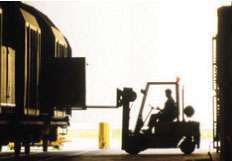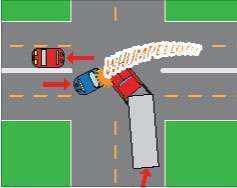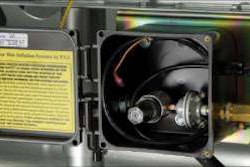CSA 2010 draws commercial attention
Firms offer products related to FMCSA initiative
If motor carriers struggle with the Federal Motor Carrier Safety Administration’s new approach toward safety oversight, it won’t be for lack of support from the private sector. In recent weeks, several suppliers of safety and technology products and services have unveiled new offerings to help carriers cope with FMCSA’s Comprehensive Safety Analysis 2010. FMCSA released CSA 2010 data directly to carriers in April, but the agency has yet to offer tools for analyzing the data in relation to other carriers, which is necessary for scoring.
 Vendors are lining up with new offerings to help carriers cope with the Federal Motor Carrier Safety Administration’s new approach toward safety oversight, Comprehensive Safety Analysis 2010.
Vendors are lining up with new offerings to help carriers cope with the Federal Motor Carrier Safety Administration’s new approach toward safety oversight, Comprehensive Safety Analysis 2010.J.J. Keller & Associates (www.jjkeller.com) launched CSA Management Suite to help transportation professionals prepare for and manage their safety compliance programs under CSA 2010. J.J. Keller says its CSA Management Suite interacts with FMCSA’s Safety Measurement System (SMS) so that carriers have up-to-date accident, violation and roadside inspection data to generate a safety rating and see how they will stack up in CSA 2010. The company says the online service acts as an early warning system that enables carriers to conduct internal audits and implement corrective actions to resolve any potential violations.
CSA Management Suite will help subscribers evaluate their situation, identify the steps they can take to improve and implement safety compliance programs to decrease their likelihood of a FMCSA intervention, says James Keller, president and chief operating officer of J.J. Keller.
The CSA Management Suite includes tracking tools for accidents and roadside inspections; a self-audit tool that determines a carrier’s safety fitness rating and recommends corrective actions; a comprehensive dashboard to keep carriers informed of where they stand with each CSA 2010 BASIC in terms of drivers, units, crashes and violations; 30 prewritten company policy templates; reporting and analysis tools to provide early warning reports; and unlimited access to J.J. Keller’s experts via the Personal Assistant tool.
PeopleNet (www.peoplenetonline.com) recently introduced a “CSA 2010 bundle,” which the company sees as a comprehensive approach to meeting safety goals under FMCSA’s program. In addition to managing drivers’ hours of service with eDriver Logs, the CSA 2010 bundle includes other safety applications such as Onboard Event Recording, Speedgauge, engine fault code monitoring, speed alarms and more. The bundle also includes onsite help by PeopleNet Professional Services to ensure CSA 2010 readiness by helping customers understand how to use the technology to assess, measure and impact safety performance.
The new bundled resources are key to managing driver and carrier performance that will mitigate the impact of CSA 2010’s stringent standards, says Brian McLaughlin, PeopleNet’s COO. “More and heavier fines are on the horizon, according to the FMCSA,” McLaughlin says. “It estimates that carriers will have an 8.5 times greater chance of incurring heavier fines and being mandated what their operation must do to become compliant.” Five of the top 10 most frequent violations are related to HOS, and “eDriver Logs is critical for avoiding these violations,” he adds.
Proactive measures
Another fleet management system vendor, Qualcomm (www.qualcomm.com), is working with FleetRisk Advisors (www.fleetriskadvisors.com) to offer the CSA 2010 Safety Performance Service, which is powered by FleetRisk Advisors’ The Driving Center. The new service, scheduled to be available this fall, will incorporate information from FMCSA’s SMS database and vehicle-specific safety performance information from a variety of Qualcomm services to provide predictive tools to identify potential problem areas in future inspections. The service also will provide proactive training/driver coaching modules to address identified issues.
“CSA 2010 Safety Performance Service gives fleets a new way to proactively manage compliance with these critical and complex regulations,” says Norm Ellis, vice president of sales, services and marketing for Qualcomm Enterprise Services.
“Scorecards look at what has already happened, and in the new CSA 2010 environment, that is too late,” says Sam Wilkes, chief executive officer of FleetRisk Advisors.
TMW Systems (www.tmwsystems.com) last month announced that it would be providing to its carrier customers a free CSA 2010 data monitoring tool called CSA Management. TMW is offering the tool first to customers in CSA test states and will expand access as the reach of FMCSA’s program grows.
“Our CSA Management online service will further help carriers monitor their all-important CSA safety ratings to stay on top of potentially negative trends, identify specific problem areas requiring attention and even spot data inaccuracies that may warrant challenge,” says David Wangler, president and CEO.
Rair (www.rair.com) recently released a free monthly CSA 2010 scorecard to provide all carriers with percentile rankings against their peers. “Our goal is to help ensure that our clients are never subject to an intervention by the DOT,” says JJ Singh, president and CEO.
Likely the first company to provide a CSA 2010 scorecard was Vigillo (www.vigillo.com), which launched its offering in November. The American Trucking Associations endorsed the scorecard in February, and in March, the company announced enhancements to its CSA 2010 product offering. For example, the Vigillo Inspection Root Cause Scorecard helps identify drivers whose behavior is leading to unnecessary inspections. In late April, Vigillo announced that more than 1,300 carriers were scoring more than 500,000 drivers through its CSA 2010 offerings.
“When the FMCSA released its CSA 2010 Data Preview product on April 12, we thought our sales trajectory might slow down, but just the opposite has happened,” says Steve Bryan, president of Vigillo. “The carriers are rapidly realizing that even with access to the FMCSA’s information, they need more than just the raw data provided.”
For more information on CSA 2010, go to http://www.csa2010.fmcsa.dot.gov. – Avery Vise
In brief
* The U.S. Department of Transportation is seeking public comment to help finalize a strategic plan, “Transportation for a New Generation.” The plan helps set DOT priorities and offers a blueprint for providing the traveling public with safe, convenient, affordable and environmentally sustainable transportation choices for the 21st century.
* The Truck Safety Coalition presented its first-ever Distinguished Safety Leadership award to Don Osterberg, vice president of safety, security and driver training for Green Bay, Wis.-based Schneider National, during a reception at the Sleep Apnea & Trucking Conference in Baltimore.
* Labelmaster (www.labelmaster.com) will hold its fifth annual Dangerous Goods Instructor’s Symposium Sept. 22-24 at the Embassy Suites Hotel in downtown Chicago. The event will include up-to-date regulatory information, training workshops and industry speakers.
* Covenant Transport was honored for its safety record at the California Trucking Association’s Fleet Safety Awards Banquet in Sacramento. Covenant received first place in the General Commodity Truckload Over 7 Million Miles Division and first place in the Local Under 4 Million Miles Division.
* Xtra Lease’s 30-page 2010 Size & Weight Guide offers details on where to register for fuel use tax and order IFTA trip permits; register vehicles and order IRP trip permits; register for the UCRA; get hazardous materials/waste permits; and get overweight and/or oversize permits. To obtain a free booklet, go to www.xtralease.com/2010sizeweight.
PHMSA launches online hazmat permit process
 The Pipeline and Hazardous Materials Safety Administration says its online system will allow it to review and process special permits and applications more efficiently.
The Pipeline and Hazardous Materials Safety Administration says its online system will allow it to review and process special permits and applications more efficiently.Applications for hazardous materials special permits will be reviewed in a more timely and efficient manner as the result of a new online application process launched by the U.S. Department of Transportation and its Pipeline and Hazardous Materials Safety Administration. The new system – part of an officewide modernization effort in the Office of Hazardous Materials Safety – accepts applications 24 hours a day, provides immediate confirmation of an application along with a tracking number and allows an applicant to attach supporting documentation. The online application Web link can be found at www.phmsa.dot.gov/hazmat/regs/sp-a.
“PHMSA is developing and implementing plans and solutions in an ongoing effort to improve the efficiency and transparency of our hazardous materials safety program and to better serve the American public,” says PHMSA Administrator Cynthia Quarterman.
Preventable or not:
Doe’s northbound turn goes south
Energized by a nutritious breakfast from the low-calorie menu at Hattie’s Heart of North Carolina Truckstop, trucker John Doe hopped back onto Yawl Road and pointed his chrome bulldog eastward toward Greensboro under a blue, cloudless late spring sky. Arriving at the stop sign-controlled intersection with four-lane Federal Highway, where he intended to head north, Doe entered and blocked the southbound lanes – whose sole occupant, a blue 1988 Buick piloted by Granny Cirillo, was several city blocks away – and slowed for a northbound pickup to clear the intersection before proceeding.
 While waiting to complete a left turn onto a four-lane highway, John Doe had blocked the southbound lanes, where he was struck by a car. Was this a preventable accident?
While waiting to complete a left turn onto a four-lane highway, John Doe had blocked the southbound lanes, where he was struck by a car. Was this a preventable accident?HONK! HONK! Holy catfish! Instead of braking, Cirillo had rocketed blindly toward Doe’s truck and, while leaning on her horn, was attempting to careen around the front of … WHUMPELLO!!! “Oh no!!!” Doe shouted to himself at the moment of impact. Fortunately, no one was injured.
That didn’t stop Doe’s safety director from issuing a preventable-accident warning letter, which Doe promptly contested, arguing that the crazed Cirillo had attacked viciously and without provocation. The National Safety Council’s Accident Review Committee was asked to resolve the conflict.
Alas, NSC quickly ruled against Doe, noting that blocking lanes doesn’t preclude vehicular assault, and that if he had bothered to look, Doe would have detected the impending kamikaze attack and averted it by remaining stationary until Cirillo had whizzed around his rig. n











